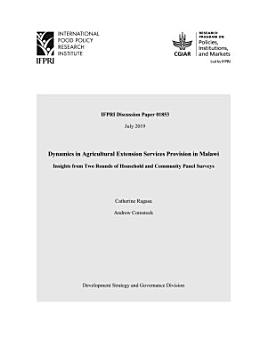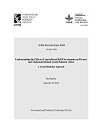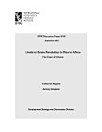Dynamics in agricultural extension services provision in Malawi: Insights from two rounds of household and community panel surveys
Ragasa, Catherine · Comstock, Andrew
Aga 2019 · IFPRI Discussion Paper Ibhuku elingu-1 · Intl Food Policy Res Inst
I-Ebook
50
Amakhasi
family_home
Kufanelekile
info
reportIzilinganiso nezibuyekezo aziqinisekisiwe Funda Kabanzi
Mayelana nale ebook
The Government of Malawi is in the process of developing its National Agricultural Extension Strategy. Two rounds of national household and community surveys (2016, 2018), coupled with in-depth interviews and focus group discussions, were implemented to provide research evidence supporting the Strategy’s development. This paper summarizes emerging trends from these surveys and monitors progress in extension services provision, players and actors in extension services provision, and evidence on the coverage and effectiveness of extension approaches. Positive trends include (1) improvements in the percentage of men and women farmers accessing extension services; (2) consistently high ratings in the perceived quality of extension services; (3) more diversity in extension messages, including more information regarding market access and nutrition; (4) greater use of cost-effective tools, such as radio programming and community or group meetings, as sources of agricultural information; and (5) greater crop diversification, although diversification outside of agriculture remains low. Four areas remain weak and need further improvements. First, information sharing among farmers, friends, and neighbors is frequent, and the coverage of those officially trained “lead farmers” (those trained specifically to promote technologies to other farmers) remains low, with only 7 percent of households reporting getting relevant advice from them. Second, while there are more “model villages” and “village agricultural committees” present, we see decreasing participation and ratings for these. Third, we observe greater awareness of promoted technologies, including conservation agriculture, pit planting, and sustainable land practices, but adoption remains very low. Fourth, we observe greater crop diversification, but farm productivity and commercialization remain low. Although we have investigated many dimensions and factors in this paper, there remain challenges and puzzles that could be further addressed in future research. These include constraints on the adoption of minimal expensive inputs and low-cost management practices, constraints on the role of intensive training and labor, and understanding the drivers and factors affecting commercialization and diversification.
Nikeza le ebook isilinganiso
Sitshele ukuthi ucabangani.
Ulwazi lokufunda
Amasmathifoni namathebulethi
Faka uhlelo lokusebenza lwe-Google Play Amabhuku lwe-Android ne-iPad/iPhone. Livunyelaniswa ngokuzenzakalela ne-akhawunti yakho liphinde likuvumele ukuthi ufunde uxhunywe ku-inthanethi noma ungaxhunyiwe noma ngabe ukuphi.
Amakhompyutha aphathekayo namakhompyutha
Ungalalela ama-audiobook athengwe ku-Google Play usebenzisa isiphequluli sewebhu sekhompuyutha yakho.
Ama-eReaders namanye amadivayisi
Ukuze ufunde kumadivayisi e-e-ink afana ne-Kobo eReaders, uzodinga ukudawuniloda ifayela futhi ulidlulisele kudivayisi yakho. Landela imiyalelo Yesikhungo Sosizo eningiliziwe ukuze udlulise amafayela kuma-eReader asekelwayo.











